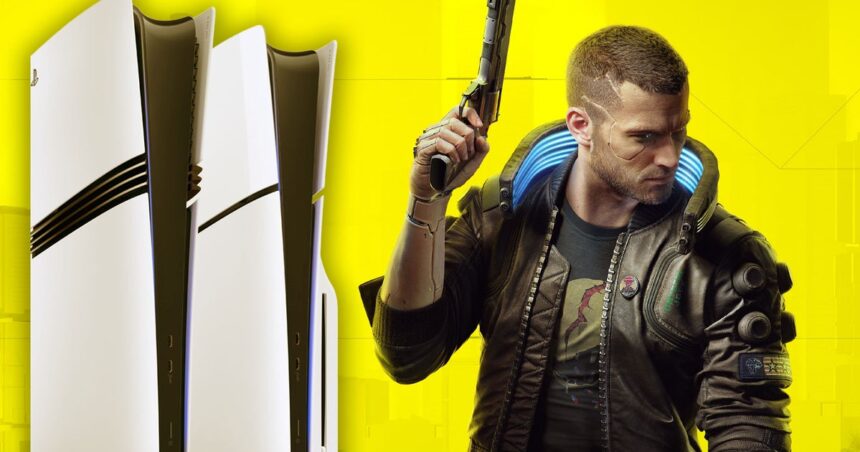Cyberpunk 2077 was updated last week to version 2.3, bringing with it a range of new features, including enhanced upscaling support on the PC version of the game. However, it’s the addition of console VRR that intrigued me. What does it actually do to the game’s existing 30fps RT/quality and 60fps performance modes – and by extension, what about PlayStation 5 Pro? The new update doesn’t actually deliver any bespoke support for Sony’s enhanced console, but unlocked frame-rates via VRR should definitely tap into the Pro’s additional performance – and this may well be the closest we’ll get to a Pro patch. Xbox? I tested Series X and I couldn’t seem to see any difference with VRR enabled.
In testing the VRR support for Cyberpunk 2077, I used a range of internal CDPR tests that are found within the PC version of the game, which can be “ported” across to any console release by using the cross-save system. This gives us entirely like-for-like sequences that allow us to get a handle on how performance changes with VRR enabled. And accessing these modes is as simple as turning on VRR on the console dashboard with 120Hz enabled. On PlayStation consoles at least, this unlocks frame-rate on the 30fps RT mode, running to a maximum of 40 frames per second. Meanwhile, performance mode lifts the 60fps cap, allowing for frame-rates to potentially hit 120 frames per second.
On Series X, the lack of any difference to standard play does stick out – according to my LG CX OLED display, the console is outputting a VRR signal, but the refresh sticks to 118Hz – something that happens when VRR is not operating correctly. RT mode still runs at 30fps, performance mode at a capped 60fps – unless there’s something specifically wrong with my set-up, Xbox VRR needs a fix. However, it may well be the case that the gains you’d notionally receive will be minor anyway – as VRR support doesn’t actually benefit the base PlayStation 5 that much in my tests, so I’d expect the same thing to happen on Series X.
- 0:00:00 Introduction
- 0:01:15 News 1: Cyberpunk 2077 2.3 update brings console VRR support
- 0:13:42 News 2: Space Marine 2 ges RTAO on PC
- 0:24:01 News 3: Donkey Kong Bananza originally planned for Switch 1
- 0:46:00 News 4: Hitman changes settings based on output res on Switch 2
- 1:01:53 News 5: DOOM SNES gets new Randy Linden port
- 1:14:14 News 6: RDNA 4 suffers from broken RT in UE4 games
- 1:21:20 Supporter Q1: How helpful will neural texture compression be for memory-constrained gaming hardware?
- 1:29:59 Supporter Q2: What are your thoughts on Nintendo’s apparent attempts to discourage third party Switch 2 docks?
- 1:37:25 Supporter Q3: Will any third party Switch 2 games use RT?
- 1:39:58 Supporter Q4: How will CPU makers improve performance in the post-Moore’s Law age?
- 1:45:24 Supporter Q5: What is Alex’s favourite type of pizza?
So, here’s how my results pan out. If we take the PC benchmark sequence and run it on the base PS5 and PS5 Pro, you’ll immediately see the issue: an average 62.84fps on the standard console falls well short of the 81.03fps average from PS5 Pro – a 28.9 percent advantage. The frames per second differential ranges from circa 10 percent to 45 percent as the sequence rolls out, so that 28.9 percent lead is not a sustained average. It is variable. However, running on a VRR screen it is clear that the Pro is much smoother.
Moving on to the Kabuki streaming test we use in our PC graphics card reviews, the base PlayStation 5 delivers a 62.32fps average, rising to 78.31fps on Pro – a 25.7 percent lead. Again, those results are variable and it’s clear that streaming in more detail environments brings more of the CPU into play, where PS5 Pro does not enjoy a huge advantage over the base unit. Even so, for the majority of the sequence, PS5 Pro is – again – a smoother experience. The final scene we tested sees us travelling at speed through the centre of the city, with particularly dense levels of detail. Again, PS5 sticks to a 62.42fps average up against Pro at 75.72fps – a mere 21 percentage point lead. And that’s for the same reason as before: streaming in more detailed environments sees the CPU have more of an impact.
On the base PS4 side of things, VRR may seem a touch pointless, but there are less demanding areas of the game that will see more palpable advantages over the standard 60fps performance mode – and perhaps more to the point, VRR takes the game out of v-sync completely, so users should experience improved input lag. There is another cost to VRR support though – lower resolution. Both PS5 and PS5 Pro top out at 1440p native pixel counts and dynamic resolution is in play. Tom Morgan did the counts, finding a 2134×1200 dynamic resolution window on the base PS5, though Pro doggedly stuck to the maximum 1440p. With VRR off, the game should default to the prior 1260p to 1728p DRS range we’ve reported on previously.
The situation with the alternative RT mode is fairly straightforward and can be summed up quickly: the 30fps cap is removed, allowing frame-rates to reach 40 frames per second. However, it’s only the PS5 Professional that hits the target consistently in our three tests. The base unit averages at around 35 frames per second. Low frame-rate compensation is used here to keep the presentation smooth, but I’ll be honest – on the base PS5, I prefer the absolute consistency of a locked 30 frames per second. Even with VRR, something doesn’t look right when frame-rate is unlocked. The Pro does a fairly good job of presenting with a locked 25ms refresh, but I’d still stick to the locked or VRR-unlocked performance mode.
Based on pixel counts, resolution sticks to 1440p, but the truth is that the quality settings chosen for the RT mode are not that much different to the performance mode. You do get ray traced local shadows, but the effect is quite subtle and not worth the massive impact to frame-rate. This particular settings selection has never been particularly worthwhile and VRR – even up to 40fps – doesn’t make this mode appealing.
Still, performance mode on PS5 Pro is well worth checking out. Going beyond the CD Projekt RED test sequences, I found that the introduction to the Nomad character could hit 90 frames per second, while looking to the sky saw us top out at 120fps, showing that this mode is indeed fully unlocked. Frame-rates in the 70-80fps window were commonplace, but it’s worth pointing out that there are limits, both in terms of CPU and GPU. When V first leaves their apartment and enters Night City, switching to night-time saw frame-rates barely exceed 60fps on Pro. The Black Market from the Phantom Liberty also barely cleared the 60fps limit. Both of these examples are GPU limits, I’d venture to suggest. Meanwhile, running at speed around the Cherry Blossom Marketplace is (curiously enough) one of the most CPU-heavy areas of the game. Here, frame-rates dropped below the 60fps threshold.
To see this content please enable targeting cookies.
Even so, with no commitment from CD Projekt RED to support PlayStation 5 Pro, the VRR support is pretty much the only way to exercise the hardware more thoroughly. Without VRR, what you’re looking at is a game that only “tidies up” the rare frame-rate drops found on the base console, while increasing overall rendering resolution in a game which does use dynamic scaling.
All of which raises the question of what a Pro-enhanced Cyberpunk 2077 might actually look like if CD Projekt RED were to commit to a bespoke upgrade. Well, the VRR upgrade does essentially give you a 40fps balanced mode, I guess, but the RT shadows of the quality mode generally fail to impress. Speaking with the team on DF Direct this week, we’re agreed that implementing ray-traced reflections and lighting would offer a far more transformative experience. Alex’s optimised RT settings from back in the day identified these as the two most impressive effects – and to get the lion’s share of the RT lighting experience, just the medium preset was enough, with no need to opt for ultra or indeed the “psycho” preset.
I’ve approached CD Projekt RED with questions on the Xbox turnout and for more technical detail on the VRR implementation. In the meantime, Cyberpunk 2077 VRR testing amounts to just 12 minutes of “content” within the latest episode of DF Direct Weekly, with other stories including RT ambient occlusion support added to Space Marine 2 on PC, Limited Run Games’ remarkable new Doom SNES cartridge, issues with RDNA 4 GPUs stuttering badly with RT effects in Unreal Engine 4 games, John’s thoughts on reactions to his Donkey Kong Bananza review and much more! We love the Direct, which thrives on community support via the DF Supporter Program. All Supporters get early access to the show, so if you enjoy our work, please consider joining us!





